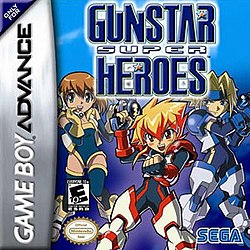This article possibly contains original research .(December 2007) |
| Gunstar Super Heroes | |
|---|---|
 | |
| Developer | Treasure |
| Publishers | Sega (JP/NA) THQ (EU) |
| Director | Tetsu Okano |
| Producer | Masato Maegawa |
| Designer | Hideyuki Suganami |
| Programmer | Kazuhiko Ishida |
| Artist | Tetsuhiko Kikuchi |
| Writer | Tetsu Okano |
| Composer | Norio Hanzawa |
| Platform | Game Boy Advance |
| Release |
|
| Genre | Run and gun |
| Mode | Single-player |
Gunstar Super Heroes [a] (also known as Gunstar Future Heroes in Europe) is a run and gun video game for the Game Boy Advance developed by Treasure and published by Sega in 2005. It is the sequel to the 1993 Sega Genesis game Gunstar Heroes , with the story taking place after the events of the original game and featuring an expanded combat system over its predecessor.